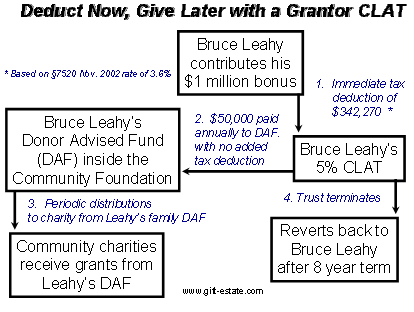Why It Makes Sense to Let a Charity Use Your Money
Why It Makes Sense to Let a Charity Use Your Money
The Grantor Charitable Lead Annuity Trust

Bruce Leahy and his wife LeeAnn have had a long relationship with a local private elementary school and serve on the board of directors for two other charitable organizations. As year-end approaches, Bruce finds that he is due to receive a significant bonus from his employer, a pharmaceutical manufacturer, for a patent and some cutting-edge research that Bruce guided through the regulatory process. While he and his wife are comfortable now, they cannot afford to give up the bonus with an outright gift to charity. However, they feel that they can do without the money for the next eight years. Rather than give the entire bonus, they have opted to use a grantor lead trust and provide annual support to charity while they are working. The CLAT generates an immediate income tax deduction of $342,270 even though the future payments to charity take place over eight years. This deduction will help offset some of their increased income tax liability, and that makes it a little more helpful since Bruces bonus will push them into the top marginal bracket this year. In effect, this plan allows the Leahys to loan the moneys use to support their philanthropic interests as long as they reacquire their seed money before retirement.
|
Year |
Beginning Principal |
5.00% Growth |
Annual Payment |
Remainder |
|
1 |
$1,000,000 |
$50,000 |
$50,000 |
$1,000,000 |
|
2 |
$1,000,000 |
$50,000 |
$50,000 |
$1,000,000 |
|
3 |
$1,000,000 |
$50,000 |
$50,000 |
$1,000,000 |
|
4 |
$1,000,000 |
$50,000 |
$50,000 |
$1,000,000 |
|
5 |
$1,000,000 |
$50,000 |
$50,000 |
$1,000,000 |
|
6 |
$1,000,000 |
$50,000 |
$50,000 |
$1,000,000 |
|
7 |
$1,000,000 |
$50,000 |
$50,000 |
$1,000,000 |
|
8 |
$1,000,000 |
$50,000 |
$50,000 |
$1,000,000 |
|
Totals: |
$1,000,000 |
$400,000 |
$400,000 |
$1,000,000 |
As it turns out, the current and extraordinarily low §7520 rate of 3.6% makes their gift planning an especially attractive option. When the applicable federal rate (AFR) is this low, the lead annuity trust, private annuities, grantor retained annuity trusts and charitable gifts of the remainder interest in a farm or personal residence are most tax efficient. For donors who regularly make annual charitable contributions and may not always itemize or qualify for a Schedule deduction, the use of a lead trust now gives them an effective way to deduct their philanthropic support and do it up front.
By making annual contributions of $50,000 to their donor advised fund, the Leahys could create an account that functions like a quasi-private foundation with the infrastructure and oversight of a 501(c)3 public charity. This strategy allows Bruce and LeeAnn to pre-fund their DAF while they are in a position to use their combined salaries to maintain lifestyle and still make judicious future distributions over many years. With most community foundations, the families have the ability to continue making recommendations for grants over several generations, and involve heirs with charity.
For people trying to reduce gift or estate taxes, there is a related lead trust that gives up the income tax deduction in favor of an estate and gift tax deduction. This non-grantor trust, paying income to charity with the remainder distributed to heirs, also makes sense during this period of historically low discount rates. For individuals who do not need the principal back, the use of a non-grantor lead trust would generate a gift tax deduction for the same amount mentioned above; therefore, the donor is able to reduce the taxable transfer to the heirs from $1,000,000 to only $657,730. If there is growth inside this trust, then this growth passes tax-free to heirs too. Professional advisors should note that it is critically important to manage investments carefully inside a non-grantor CLAT, as it is a complex, tax-paying trust, unlike the more common charitable remainder trust. However, with the Leahys grantor trust, where trust principal eventually reverts to the donor, tax on any income earned is at the donors marginal tax rate Therefore, the Leahys lead trust will invest in a combination of tax-free municipal bonds and a few non-dividend paying growth stocks to keep the trust from spinning off unwanted taxable income. Unlike the grantor trust that receives its entire tax deduction up front, the non-grantor trust receives charitable income tax deductions offsetting income otherwise taxed at compressed trust rates via annual charitable distributions. A good financial and estate plan creates a cohesive strategy that will have an ongoing impact on philanthropic activities important to the Leahy family.
